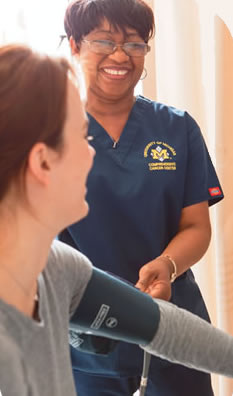Prompt and Personalized

Photo by Edda Pacifico
Oncology care when you need it -- without the ER
Have you ever gone home after chemotherapy infusion only to spike a fever and experience terrible nausea? Setting up an appointment with your primary oncologist could take days. Your regular physician might send you to the emergency room. The last thing you want to do is take yourself to the emergency room. You want oncology care and you need it now!
With the goal of meeting the needs of cancer patients, last summer marked the opening of the University of Michigan Rogel Cancer Center’s Ambulatory Treatment Center. The improved service provides ongoing support for U-M Rogel Cancer Center patients as well as regular clinic visits for physician appointments and treatment.
"We know prompt and directed care is important and valuable to our patients," says Krisinda Palazzolo, P.A.-C., and a lead team member of the Ambulatory Treatment Center. "We needed a dedicated center for cancer patients needing attention. This could be a time your oncologist is not available and your primary doctor isn't a good fit, or we don’t want you in the emergency department because you're immunosuppressed. We want patients to be able to see oncology staff."
For existing patients at home, a potential trip to the Ambulatory Treatment Center begins with a phone call to their primary Rogel Cancer Center team, just as they would normally call with a question or problem. Patient calls are then triaged through their health care team and, if the Ambulatory Treatment Center is determined to be the best resource, a visit might be scheduled.
"Identifying the best place for a patient to go is critical," Palazzolo says. "Also important is involving a patient's primary oncology team, as these individuals know the patient’s history best."
For instance, a patient might come to the Rogel Cancer Center for an infusion appointment, but is found to be dehydrated or not well enough for treatment. Infusion nurses often recognize when a patient needs attention and can work in collaboration with the patient's primary team to refer him or her to the Ambulatory Treatment Center for a more detailed and focused evaluation.
"We want to create an ideal patient experience," says Palazzolo. "Patients need prompt attention to their symptoms from oncology focused providers who are in touch with what they are experiencing."
After a visit to the Ambulatory Treatment Center, information is reported back to the patient's hematologist/oncologist to provide a seamless experience.
The Ambulatory Treatment Center
- Located in the U-M Rogel Cancer Center
- Expanded hours: 8 a.m.–8 p.m.
- Dedicated nurses and physician assistants
- P.A.s review request and contact referring physician
- New simplified referral form to expedite the process
- P.A.s contact the patient's primary oncologist after a visit
Read the Fall, 2012 issue of Thrive.
